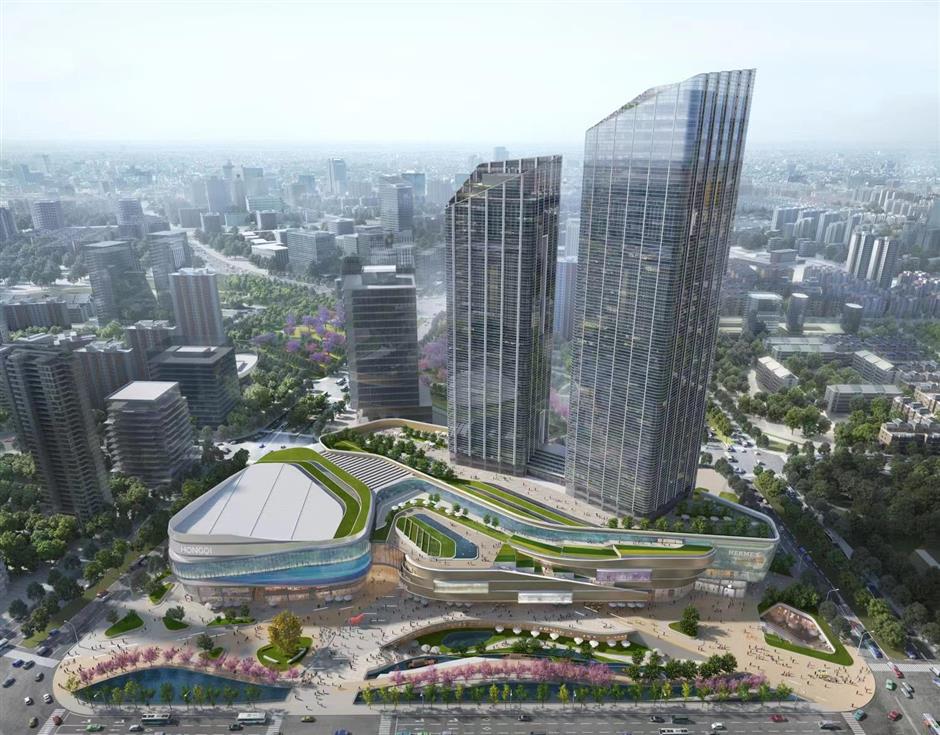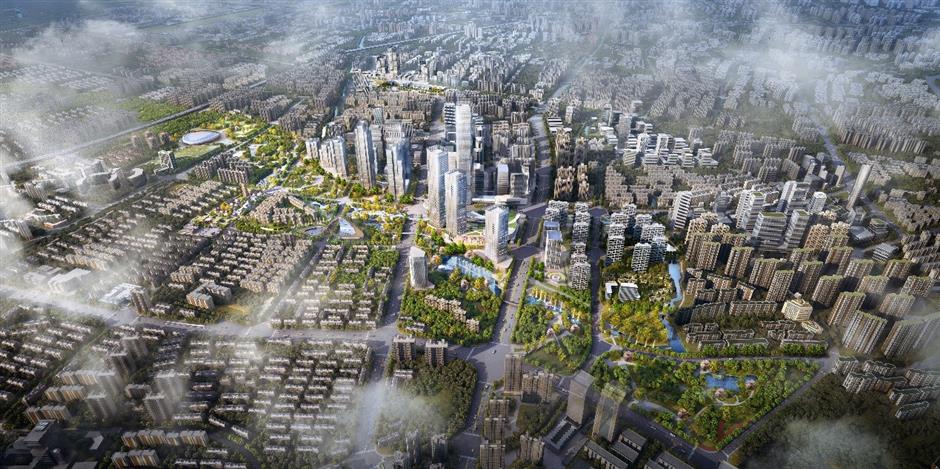
An artist's rendition of the Zhenrujing project for the ZhenruSubcenter in Putuo
Construction has begun on the Zhenru Subcenter in Putuo District, which will feature skyscrapers, commercial hubs and the largest downtown greenbelt.
The project is among the 33 key construction works which were launched on Friday in the northwest downtown, with a total budget of more than 20 billion yuan (US$3.1 billion).
They include infrastructure, new parks, schools, shopping complexes and nursing homes, along with housing renovation, which are aimed at improving the quality of people’s lives.
The Zhenru Subcenter is the fourth in the city along with Xujiahui in Xuhui District, Wujiaochang in Yangpu District and Huamu in the Pudong New Area.
It will cover 6.2 square kilometers, based around the West Railway Station and expressways connecting with the Yangtze River Delta region. The transport hub at the station handles over 40,000 passengers daily.
Construction started on Friday on the Zhenrujing project, a key commercial complex in the core region of the subcenter.
The project is being built above the Zhenru Station of Metro Line 11 and 14. The complex includes business facilities covering 300,000 square meters, shopping malls and a theater covering a total of 150,000 square meters as well as residential communities, greenbelt and underground space.
The project will become a comprehensive complex dubbed the “the great square kilometer,” according to the district government.
 Ti Gong
Ti GongAn artist's rendition of the Taopu Central Greenbelt
As a highlight within the project, construction has also started on a new landmark theater to serve as the main stage for the popular comedy and culture brand Mahua FunAge.
The Zhonghai Theater will be built at the Zhenru Subcenterwith 1,000 seats and multifunctional theaters for stage dramas and movies.
Upon its completion and grand opening by the end of 2022, the theater will feature immersive performance spaces, exhibition halls, art galleries, cafes, outdoor stages and a sightseeing platform on the rooftop which will open free to the public around the clock.
All 1,600 apartments in the high-end community within the project have been sold out. The neighborhoods will be completed by the end of the year.
Meanwhile, construction has started on the additional part of the Taopu Central Greenbelt, the largest downtown public greenbelt in Shanghai. It will cover a million square meters upon its completion. Part of the site has been opened, covering half of the planned size, on a trial operation, featuring natural landscape and its long industrial heritage.
The design of the green area is inspired by Hyde Park in London and Central Park in New York. The park theme “Floating clouds and water” incorporates traditional Chinese cultural ideas such as painting, calligraphy, dance and tai chi.
Standing on the top of the greenbelt’s artificial hill, regarded as the “second-tallest hill” in Shanghai’s western downtown, visitors can see the former site of the city’s once popular “peony ink” factory, a soap factory, a paint plant and the famous White Elephant battery factory.
 Ti Gong
Ti GongAn artist's rendition of the Zhenru Subcenter
Industrial heritage has been preserved. The city’s earliest rubber plant on Dunhuang Road, for instance, will be converted into a visitor center for the site. A statue of Chairman Mao at the former factory has been preserved.
Visitors can also find some historical sites on or near the greenbelt. Not far from the initial phase of the project, Hanta Pagoda, originating from the Southern Song Dynasty (1127-1279), has been well-preserved. It is said that general Han Shizhong (1090-1151), who devoted his life to fighting invaders, once trained soldiers beside the pagoda.
As a central attraction, a 3D-printed bridge has been put in place over a river in the greenbelt. The 15-meter S-shaped bridge was made in 35 days by a giant 3D printer.
Sightseeing paths have also been planned for the subcenter for visitors to enjoy both the riverside greenery along the Zhenrugang, Dachangpu and Taopu rivers as well as the Caoyang Community. The community sprang up in 1951 as a home to model workers of the city, and has been listed as a heritage site by the city government.
Zhenru was originally formed between 1208 and 1224 during the Song Dynasty (960-1279). A monk named Yong’an erected Zhenru Temple and built a xianghua (scented flower) bridge, which brought worshippers to the area. Markets were later developed around the temple, which still exists, along with Zhenru Pagoda.
The town, formerly known as Taoxi, or peach creek, which sat between the former Jiading and Shanghai counties, was one of the city’s four most prosperous historic marketplaces.
 Ti Gong
Ti GongAn artist's rendition ofthe Zhenru Subcenter
